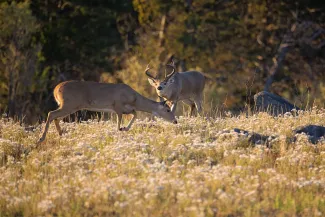As a deer hunter, you are truly a boots on the ground wildlife manager, regardless if you are hunting private or public land. Your choice to harvest, or more importantly, pass on an animal has an impact at a local population level. Harvesting antlerless deer is incredibly important when healthier deer, greater antler size, and stable population levels are management goals.

Jeremiah Zurenda
A piece of habitat can only support a certain number of deer. As more and more deer begin to utilize the habitat, the available food is spread more and more thin until it reaches a level at which animal health starts to decline. By reducing animal numbers, the share of available nutrients becomes more abundant to those animals remaining on the landscape, including bucks. Antler size is largely dependent on nutrition and so working towards a balanced sex ratio will help with the production of larger racked bucks as well as larger bodied animals.
In addition to nutrition, harvesting antlerless deer also has a positive effect on mature bucks during the rut. Bucks are so focused on breeding that they forgo rest, sleep, and even food for as long as possible. This devotion to breeding can be detrimental when a large population of does is present.
A buck-to-doe ratio that is weighted heavily towards does also leads to females that remain unbred during the primary rut. As a result, a second, third, or even fourth breeding cycle can occur. When this happens, bucks exert a tremendous amount of energy traveling great distances to rut for 2 to 3 months instead of 2 to 3 weeks. In the end, bucks are either harvested exceedingly underweight or they enter the harshness of winter in poor body condition.
Another facet of multiple rutting periods resulting from high doe populations is that fawns are born later in the spring or early summer than those that were conceived during the first rut period. The further into summer they are born, the more difficult it is for their mothers to obtain enough nutrition to produce milk in adequate volume and nutrients. In addition, late born fawns are forced to race the clock to obtain nutrients from dry, desiccated summer forages. For many late born fawns, that time period simply isn’t enough and they enter their first winter undersized and undernourished. Research has shown that late born buck fawns can take 3 years to reach similar antler sizes of those born earlier in the spring.
Simply put, reducing the buck-to-doe ratio improves antler quality potential on a property by increasing the nutritional availability on your land, reducing the rut to a short but intense time period, and reducing the frequency of late born fawns. It also offers enhanced fawn survival and provides more pounds of deer meat from each animal harvested.
The Oklahoma Department of Wildlife Conservation liberalized the bag limits and season dates for antlerless deer starting with the 2020-2021 seasons. Deer management and antlerless harvest go hand in hand, and biologists challenge land managers and deer hunters alike to practice both.